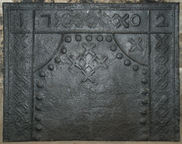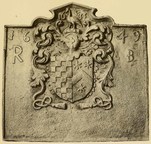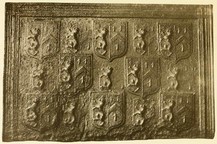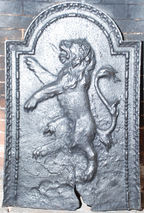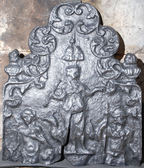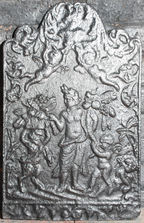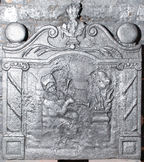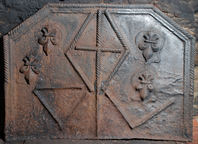-
1022
Description: Rectangular, with double fillet edging (top and sides); fillets parallel to top and to each side, dividing the plate into two square corner panels and narrow rectangular panels along top and down each side; fillet arc across inside top corners; date split between top corners, divided by vertical fillets, and separated by a hollow saltire stamp repeated six times; one hollow saltire, with a central bead, between each corner arc; eight similar saltire stamps down each side panel; 27 'daisy heads' arranged regularly around outer edge of central panel, with five saltires arranged in a cross shape in the centre.
Notes: The arc shape and use of repeated 'daisy heads' suggests a common source with other firebacks of the same period; the poor definition is due to insufficient impression at the moulding stage.
Inscription: 17 02
- Decoration tags:
- rectangular (shape)
- fillet (edging)
- carved stamps
- individual numbers
Manufactured: in 1702 in the Forest of Dean area of England.
Current location: Tolsey Museum, 126 High Street, Burford, Oxfordshire, England.
(part of the Tolsey Museum, Burford museum group)
- Attached to series:
- Hollow saltire series
- Newent area group
-
831
Description: Rectangular with small detached pediment; cavetto-moulded edging; upper centre, shield, helm, crest and mantling, with date, 1635, split either side of crest; top, date, 1649, split either side of armorial; initials split either side of armorial, below date.
Notes: The armorial, tentatively associated with the family of Brooke or Broke of Madeley, Shropshire (blazon: chequy argent and sable, impaling a chevron between three estoiles), dated 1635, was formed from a pattern designed for a smaller fireback (see no. 917), but positioned on a larger backing board with the later date and initials added separately, most of the frame of the original fireback being pared away. From an illustration in the catalogue of an exhibition on heraldry at Burlington House, London, in 1894.
Inscription: 16 35 / 16 49 / R B
Arms: poss. Brooke or Broke of Staffordshire
- Decoration tags:
- rectangular with detached pediment (shape)
- cavetto (edging)
- carved stamps
- carved pattern panels
- composite
- individual letters
- individual numbers
- armorial
- text
Manufactured: in 1649 in England.
Current location: not known.
- Attached to series:
- Personal armorial firebacks
- Composite firebacks
-
202
Description: Rectangular; edging formed from furniture moulding; shield of Ayloffe impaling Sulyard impressed weakly seven times (2-3-2), with the same shield impressed eight times (3-2-3), more deeply, in the spaces between the first shields.
Notes: William Ayloffe (c1535-1584) of Bretons, Hornchurch, Essex, Justice of the Court of Queen’s Bench, married (c1560) Jane, dau. of Sir Eustace Sulyard, of Runwell, Essex. A large number of variants use the same shields. Several copies are known of this fireback, but in precisely the same arrangement, all poorly cast, unlike the variants without the additional shields, which are found in many different arrangements, some with dates and initials. From an illustration in the catalogue of an exhibition on heraldry at Burlington House, London, in 1894, it then being at Manor Farm, Edenbridge, Kent.
Copies of this fireback are known.
Arms: Ayloffe impaling Sulyard (William Ayloffe of Bretons, Hornchurch)
- Decoration tags:
- rectangular (shape)
- complex, furniture-derived (edging)
- carved stamps
- heraldic
- armorial
Manufactured: in the early-17th century in the Weald area of England.
Current location: not known.
- Attached to series:
- Ayloffe series
- Personal armorial firebacks
-
24
Description: Arched rectangular shaped with fillet and cavetto dentil moulding, and paternost bead edging inside; a lion rampant
Notes: Whole pattern. An unusually tall fireback in relation to its width.
Copies of this fireback are known.
- Decoration tags:
- rectangular with round arch (shape)
- cavetto dentil (edging)
- whole carved pattern
- heraldic
- animals
Manufactured: in the 18th century in England.
Current location: Bateman's, Burwash, East Sussex, England.
Museum number: 761107 (part of the National Trust museum group)
- Attached to series:
- Miscellaneous pattern firebacks
-
25
Description: Quasi-arched rectangular shape with arch decorated with floral swirls and an urn on each shoulder; three female figures: Aphrodite on the left, Hera in the centre on a plinth with two peacocks behind her, and Athena on the right; a double tassel hangs above Hera’s head.
Notes: The figures are the participants in the Judgement of Paris, the outcome of which precipitated the Trojan War.
Copies of this fireback are known.
- Decoration tags:
- rectangular with ornate arch (shape)
- fillet (edging)
- whole carved pattern
- pictorial
- mythological
- humans
Manufactured: in the early-18th century in England.
Current location: Bateman's, Burwash, East Sussex, England.
Museum number: 761070 (part of the National Trust museum group)
- Attached to series:
- Late pictorial series (all)
- Late pictorial series 4
-
26
Description: Quasi-arched rectangular shape with swirled and draped foliage across the top; fillet edging with bottom panel containing indistinct floral scrolls; figure of Plenty/Abundance holding a bunch of fruit, accompanied on her left by a cherub, and receiving a further bunch of fruit from a faun to her right; two cherubs hold foliage aloft.
Notes: The figure of Plenty is one of the representations in the Iconologia, published in the early 17th century by Cesare Ripa, and subsequently in other editions. They frequently form the subject of firebacks.
Copies of this fireback are known.
- Decoration tags:
- rectangular with round arch (shape)
- fillet (edging)
- whole carved pattern
- pictorial
- allegorical
- humans
Manufactured: in the early-18th century in England.
Current location: Bateman's, Burwash, East Sussex, England.
Museum number: 761087 (part of the National Trust museum group)
- Attached to series:
- Late pictorial series (all)
-
27
Description: Arched rectangular shape with symmetrical scrolled ‘portico’ above, a flower vase between and circular discs at each end, symmetrical horizontal palm fronds below; pilaster with spiral design and Ionic capital on each side; central pictorial scene of a bagpiper with Elizabethan ruff and soft cap with feather in front of a vaulted ruin, on the right a flaming cauldron on a plinth.
Notes: This seems to be pastiche using various elements derived from other firebacks, notably the moulding and scrolled top are from the Lenard fireback , and the palm fronds are from elsewhere. The figure may be adapted from a painting of a bagpiper by Abraham Bloemaert (1564-1651).
Copies of this fireback are known.
- Decoration tags:
- rectangular with ornate arch (shape)
- none (edging)
- whole carved pattern
- pictorial
- humans
- objects
Manufactured: in England.
Current location: Bateman's, Burwash, East Sussex, England.
Museum number: 761118 (part of the National Trust museum group)
- Attached to series:
- British 'Dutch' style firebacks
-
28
Description: Rectangular with pediment raised on inverted consoles; ovolo, egg and dart edging; shield, garter, helm, mantling, crest and motto of the English House of Stuart; date split either side of garter buckle.
Notes: One of several firebacks, all of the same date, but varying in size, framing style and moulding; all have stylistic features in common and will have been the work of the same pattern maker, who was also responsible for carving royal coats of arms in three West Country churches.
Copies of this fireback are known.
Inscription: HONY SOIT QVI MAL Y PENSE / 16 18 / DIEV ET MON DROIT
Arms: English Stuart royal (James I)
- Decoration tags:
- rectangular with detached pediment (shape)
- ovolo, egg and dart (edging)
- whole carved pattern
- armorial
- royal
- text
Manufactured: in 1618 possibly in the Forest of Dean area of England.
Current location: Bateman's, Burwash, East Sussex, England.
Museum number: 761132 (part of the National Trust museum group)
-
29
Description: Rectangular; cavetto moulded edging; initials in top left corner; date in top right corner.
Notes: The style of lettering and numerals is reminiscent of those seen on firebacks associated with the Sidneys, Earls of Leicester, and may suggest a common source.
Inscription: IB 1695
- Decoration tags:
- rectangular (shape)
- cavetto (edging)
- individual letters
- individual numbers
- text
Manufactured: in 1695 possibly in the Weald area of England.
Current location: Bateman's, Burwash, East Sussex, England.
Museum number: 761128 (part of the National Trust museum group)
- Attached to series:
- Date & initials firebacks
-
826
Description: Canted rectangular shape with moulded edging (top and sides) overlain by a length of twisted rope repeated six times; central vertical line formed of twisted rope, crossed with rope upper centre, with rope laid in a diamond pattern around the cross; lower centre, two irregular v-shapes formed of rope, one on each side of the vertical; shield shaped stamp with a fleur de lys repeated twice each side, upper left and right.
Notes: The twin V arrangement may have apotropaic significance and the cross above them having a Christian symbolism; the base board appears to have had a moulded edge, with rope lengths applied over part of the moulding after the board had been pressed into the casting bed; a sketch of this fireback was made by J. Starkie Gardner c.1891 and is in his collection at the Victoria and Albert Museum, Archive of Art and Design (AAD/2014/8).
- Decoration tags:
- rectangular with canted top corners (shape)
- rope over moulding (edging)
- simple stamps
- carved stamps
- heraldic
- apotropaic
- objects
Manufactured: in the late-16th century in the Weald area of England.
Current location: in private hands, Burwash, East Sussex, England.
- Attached to series:
- Miscellaneous stamp firebacks
- Rope design firebacks
